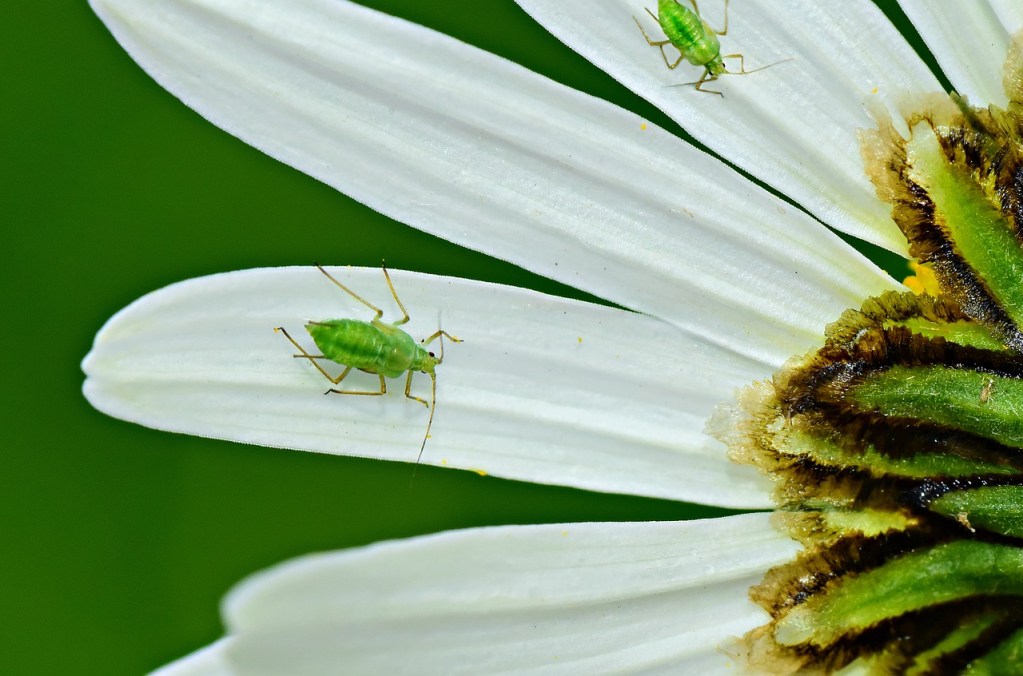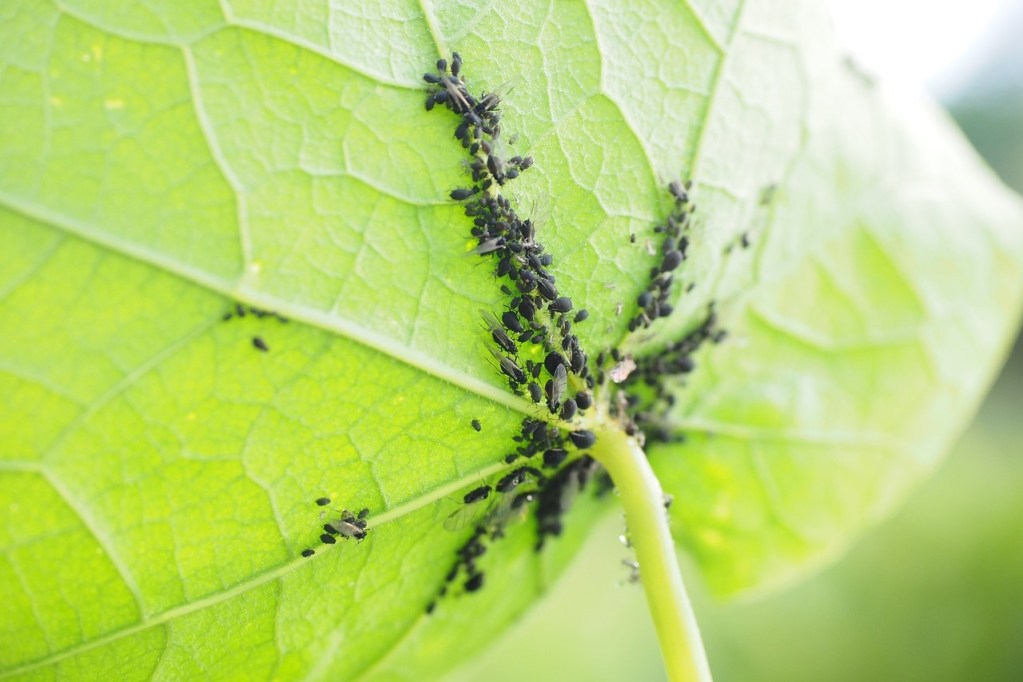
As much as we wish it weren’t true, houseplants and greenhouses aren’t exempt from pest problems. Since they’re inside, you don’t have to worry about deer or rabbits or squirrels chomping at the leaves, but bugs can still find their way indoors. Whether they buzz in through a window or hitch a ride on your pets, pests are sure to find your plants eventually. Some pests are more common across different species than others. Here are the most common types of plant pests to watch out for, and what you should do when you find them.
Mealybugs

Mealybugs are sap-sucking insects that cause gradual damage to your plants over time. Houseplants infested with this pest often exhibit yellowing leaves and leaf drop. They have a cottony appearance, which is obvious when contrasted against the green foliage and stems. For survival, they often nestle and cause damage in nooks and crannies like crowded stems or unfurled leaves.
Signs of an infestation
Because yellow leaves and leaf drop are signs of an array of problems, those things alone don’t indicate a mealybug infestation. What you want to look for, especially if some of the foliage starts to fall prematurely, are cotton-like spots on the stems and leaves. Mealybugs also leave behind a sticky substance that’s wax-like and powdery in appearance, so if your plant starts to look like it has a white film coating parts of it, chances are there’s a bug problem.
How to get rid of mealybugs so they don’t come back
Mealybug infestations can be handled in a variety of ways, depending on the size of the infestation and the kind of method you want to use. For smaller mealybug populations, you can use natural solutions like:
- Washing the mealybugs off the plant.
- Wiping them off with 70 percent rubbing alcohol.
- Using neem oil.
For larger infestations, you may want to resort to a natural homemade insect spray or even an insecticidal soap marked for houseplants.
Scale insects

There are a few different species of scale insects, the most common of which is the brown scale; however, they all cause similar problems. Scale insects can be yellow, black, or brown in appearance, aptly named for the scale-like presentation they have when they’re on the plants. Scale insects, unlike mealybugs that like to hide when they can, form clumps along the stems where they feed until there’s nothing left.
Signs of an infestation
Scale insects have similar signs of an infestation as mealybugs: yellowing leaves and premature leaf drop. Plants infested with scale will also grow slower, and you’ll notice stems starting to die back. If you see any of these signs, check the leaves, the soil, and the rest of the plant to see if there are any small bumps or clumps. These aren’t growths; they’re the insects, and they’re what you’ll be looking to remove.
How to get rid of scale insects so they don’t come back
The good news about scale insects: They aren’t that quick. Although you should inspect all of your plants when you notice signs of an infestation, it’s more likely that they’re only present on one or two as opposed to the whole bunch.
Depending on how bad the infestation is, you may want to (sadly) get rid of the plant safely. If you think there’s some hope and that the plant can be revived, you can take the following steps:
- Place a covering on the soil to prevent any scale from falling in during the removal.
- Using a natural-based insect spray (which, as mentioned early, you can make at home!), spray the plant.
- Using a toothbrush, a toothpick, or your fingernails, gently rub along the stems and leaves to remove the scale.
- Once you’re sure all the scale have been removed, you can discard the covering (along with any scale on it) and rinse the soap off the plant.
If you want to be extra sure you removed all the pests, you can repot the plant in fresh soil, safely disposing of the possibly infested dirt. If you find that a homemade spray isn’t working for you, you can try a chemical insecticidal soap — just make sure to follow the directions closer to avoid causing harm to your weakened plant.
Spider mites

Spider mites are one of the peskiest critters that commonly plague houseplants, if only because they’re not easy to spot until most of their damage is already done. Spider mites are nearly invisible to the human eye and often need to be identified on plants using a magnifying glass. For that reason, it may be beneficial to keep one on hand and make using a magnifier part of your daily or weekly plant inspection (especially if you’ve had problems with any pests in the past).
Signs of an infestation
Infestation is a bit harder to spot because you can’t readily see the mites. You may notice your leaves are starting to get damaged out of nowhere, appearing dried out, sporting new reddish-brown spots, or are developing a reddish film on the underside of the leaves. This “reddish film” is all the little mites, hanging out and doing what they do best: causing trouble.
Although brown spots on leaves can indicate an array of other problems, it’s still important to assess your plant when you notice these problems to whittle down the possible causes. Spider mites spread quickly, and if you chalk up the brown spots as under-watering or overwatering, your whole houseplant collection could be in a mess of trouble.
How to get rid of spider mites so they don’t come back
Getting rid of spider mites is no easy feat. More often than not, by the time you see the damage on a plant, it’s too weak and too far gone to revive; however, if you’re up for a challenge and want to try saving your beloved houseplant, there are a few natural remedies you can try:
- Spraying with water and increasing the humidity (mites thrive in dry conditions)
- Using neem oil
- Using a homemade natural insect spray
If these natural remedies don’t work, or if your infestation is quite large, you may want to revert to using a chemical-based insecticidal soap. These are often quite effective but can have adverse effects on the plant when used improperly. Follow the directions closely.
Aphids

Aphids are tiny insects that suck the sap out of stems and leaves. You might be most familiar with green aphids, but they can actually be a wide range of colors, including yellow, white, orange, and brown. On their own, aphids don’t do much harm, but in large groups, they can seriously weaken a plant. They can spread several plant diseases, which do far more damage than the aphids themselves.
Signs of an infestation
If the infestation is small, you may not notice the presence of aphids at all. However, severe infestations can be identified by a few signs. Look for yellowing leaves and stunted, misshapen, or curling growth. These are all signs that aphids or another sap-sucking insect have taken too much sap, and your plant can no longer get the nutrients it needs. These are also symptoms of the most common plant diseases that aphids spread.
How to get rid of aphids so they don’t come back
If the infestation is minor, it does not require any special treatment. You can keep the population of aphids down by inviting ladybugs into your yard or garden. Ladybugs eat aphids and other pest insects, which is good news for your plants. You can also treat severe aphids with an insecticidal soap, neem oil, or another organic pesticide of your choice. Harsher chemical sprays are generally unnecessary when it comes to aphids.
There is an array of other insects to keep your eyes out for, too, from thrips to whiteflies to fungus gnats. A key thing to keep in mind: Pests are attracted to weakened plants and environments. If you’re following the care needs of every plant as best as possible, it will minimize the chances of a pest infestation down the line. Healthy plants are happy plants, after all.


